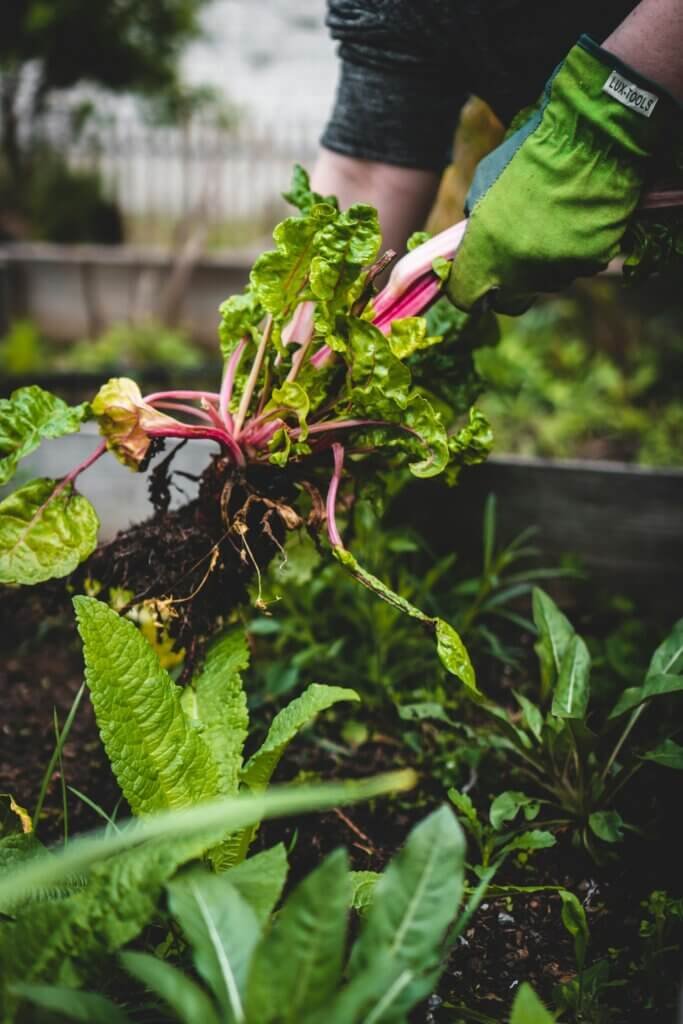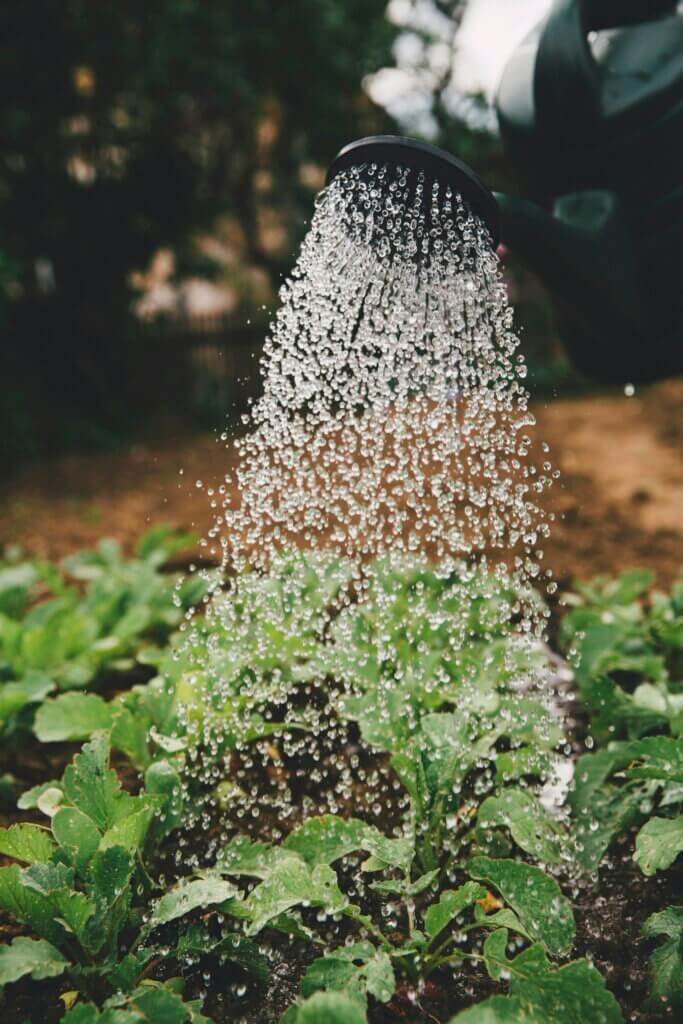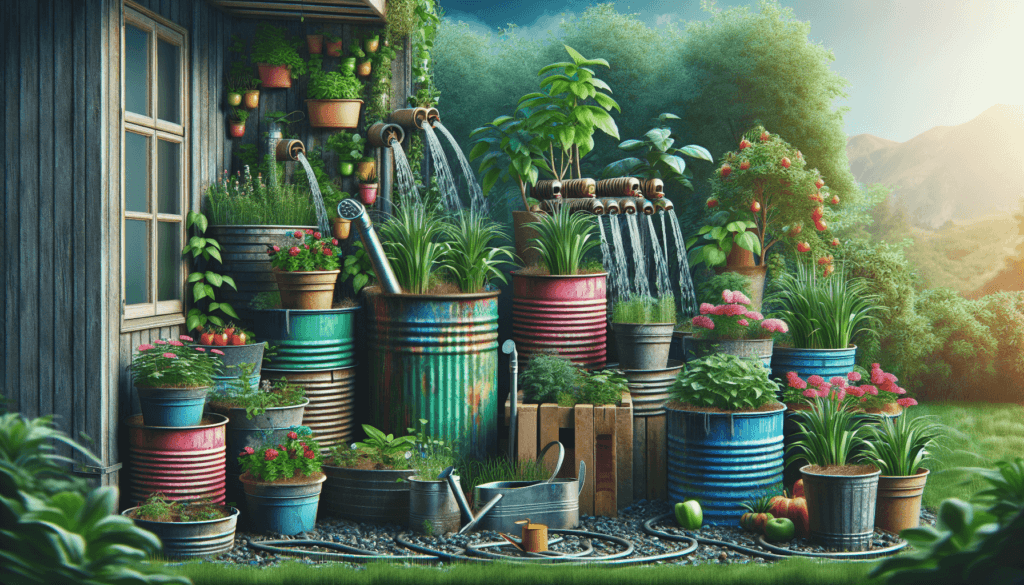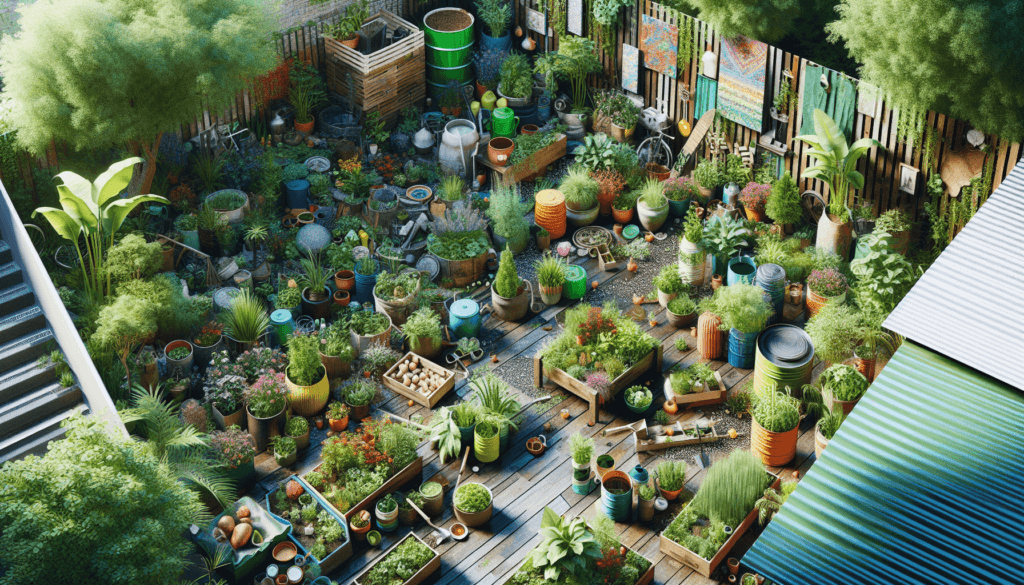Imagine transforming your outdoor space into a thriving, sustainable haven with just a touch of creativity and a sprinkle of DIY magic. In this article, we explore the top ways to create a sustainable garden using innovative and fun DIY projects. Whether you’re a green-thumb guru or a gardening novice, these ideas will inspire you to embark on a journey towards a more eco-friendly and beautiful garden that you can proudly call your own. Say goodbye to conventional gardening and embrace sustainable practices that not only benefit the environment but also provide you with a rewarding and fulfilling gardening experience. From upcycling old materials to creating your own compost, get ready to embark on a sustainable garden adventure that is both budget-friendly and environmentally conscious.
Choose Sustainable Materials
When creating a sustainable garden, it’s essential to make conscious choices about the materials you use. Opting for sustainable materials can have a significant impact on reducing waste and minimizing your carbon footprint. Here are a few key ways to choose sustainable materials for your garden:
Use reclaimed materials
One of the best ways to promote sustainability in your garden is by using reclaimed materials. Repurposing items that would otherwise end up in landfills not only reduces waste but also adds a unique touch to your garden design. Consider using old pallets for raised beds or turning salvaged bricks into a beautiful path through your garden. Reclaimed materials not only have a rustic charm but also help preserve our planet’s resources.
Opt for natural and biodegradable materials
Another way to ensure sustainability in your garden is by using natural and biodegradable materials. When selecting pots or containers for your plants, choose options made from materials such as terracotta or wood. These materials are not only eco-friendly but also provide better airflow for the roots of your plants. You can also choose biodegradable seed starting pots made from coconut coir or peat, eliminating the need for plastic trays.
Avoid toxic chemicals and synthetic materials
To create an eco-friendly garden, it’s crucial to avoid toxic chemicals and synthetic materials. Opt for organic fertilizers and pesticides that are free from harmful chemicals. These will not only protect your plants but also ensure the health of beneficial insects and wildlife. Avoid using synthetic fabrics or mulches and instead opt for options like straw, wood chips, or shredded leaves. This will enhance soil health and promote natural decomposition processes.
Water Conservation
Conserving water is vital for creating a sustainable garden, especially in regions where water scarcity is a concern. Fortunately, there are several DIY projects you can undertake to help preserve this precious resource:
Harvest rainwater
One of the most effective ways to conserve water is by harvesting rainwater. Installing a rain barrel system is a simple and cost-effective DIY project that can collect and store rainwater from your roof. This water can then be used to irrigate your garden during dry spells, reducing your reliance on freshwater sources. Collecting and utilizing rainwater not only saves water but also reduces the strain on municipal water supplies.
Install drip irrigation
Drip irrigation is another water-efficient technique that can be easily implemented in your garden. This DIY project involves setting up a system of tubes with small holes or emitters that deliver water directly to the roots of your plants. Unlike sprinkler systems that can lead to water loss through evaporation, drip irrigation delivers water precisely where it is needed, minimizing waste. By using this method, you can reduce water usage by up to 50% compared to conventional watering methods.
Mulching to retain moisture
Mulching is a simple yet effective technique to conserve water in your garden. By adding a layer of organic mulch, such as wood chips or straw, around your plants, you can significantly reduce evaporation and retain moisture in the soil. Mulch acts as a protective barrier, regulating soil temperature and preventing water runoff. This method not only helps conserve water but also improves soil health by providing a steady release of nutrients as the mulch decomposes.

Compost and Soil Health
Maintaining healthy soil is an essential aspect of sustainable gardening. By creating a composting system and using compost in your soil, you can improve fertility, enhance water retention, and reduce the need for chemical fertilizers. Here’s how:
Create a composting system
Composting is a simple and effective way to recycle organic waste from your garden and kitchen. Start by designating a compost area in your garden or using a compost bin. Collect kitchen scraps, yard waste, and other organic materials like leaves, grass clippings, and coffee grounds. Layer these materials, ensuring a balance of carbon-rich browns (such as dried leaves) and nitrogen-rich greens (such as vegetable scraps). Turn the pile occasionally to facilitate decomposition, and within a few months, you’ll have nutrient-rich compost to improve your soil.
Use compost in your soil
Once your compost is ready, incorporate it into your garden soil. The rich organic matter in compost improves soil structure, allowing for better aeration and root penetration. It also helps retain moisture, reducing the need for frequent watering. By adding compost to your soil, you’ll enhance its fertility and provide essential nutrients to your plants, resulting in healthier growth and increased resistance to pests and diseases.
Plant cover crops for soil health
Another way to improve soil health is by planting cover crops. Cover crops are specific plants that are grown primarily to benefit the soil rather than for harvest. These crops help prevent erosion, suppress weed growth, and add organic matter when turned into the soil. Legumes like clover and vetch are particularly beneficial, as they fix nitrogen from the atmosphere and make it available to other plants. By incorporating cover crops into your gardening routine, you can naturally enhance soil fertility and reduce the need for synthetic fertilizers.
Plant Selection and Placement
Choosing the right plants and placing them strategically in your garden can greatly contribute to its sustainability. By selecting native and drought-resistant plants, grouping plants with similar water needs, and practicing companion planting, you can create a harmonious and environmentally friendly garden.
Choose native and drought-resistant plants
Selecting native plants for your garden is not only environmentally responsible but also beneficial for local wildlife. Native plants have adapted to the local climate and require minimal water once established. These plants are more resistant to pests and diseases, reducing the need for chemical interventions. Additionally, native plants provide food and shelter for native birds, butterflies, and bees, supporting the local ecosystem.
Group plants with similar water needs
Efficient water management can be achieved by grouping plants with similar water requirements together. This practice, known as hydrozoning, ensures that plants receive adequate irrigation without wasting water on species that do not need it. By creating separate hydrozones, you can tailor your watering schedule to each area’s specific needs, reducing water consumption and promoting water conservation in your garden.
Consider companion planting for pest control
Companion planting is a time-honored practice that involves planting mutually beneficial species close together. This technique encourages natural pest control by attracting beneficial insects that prey on garden pests or repel them through scent. For example, planting marigolds alongside tomatoes can deter nematodes, while planting dill or parsley near lettuce can attract beneficial wasps that prey on aphids. By practicing companion planting, you can reduce the need for chemical pesticides and promote a healthier, more sustainable garden ecosystem.

Attract Pollinators and Beneficial Insects
Pollinators and beneficial insects play a crucial role in maintaining a healthy garden ecosystem. By attracting these helpful creatures, you can improve pollination, increase crop yields, and naturally control garden pests. Here’s how to do it:
Plant flowers that attract pollinators
Include a variety of flowers in your garden that are known to attract pollinators such as bees, butterflies, and hummingbirds. Opt for native flowering plants, as they have evolved alongside local pollinators and provide them with the nectar and pollen they need. Some popular choices include lavender, sunflowers, coneflowers, and bee balm. By creating a pollinator-friendly garden, you not only support these vital creatures but also enhance the productivity and beauty of your garden.
Install bee houses and butterfly feeders
To further encourage pollinators, consider installing bee houses and butterfly feeders in your garden. Bee houses provide nesting spaces for solitary bees, which are excellent pollinators. Butterflies, on the other hand, are attracted to sugary liquids such as nectar. By placing a butterfly feeder filled with a simple solution of sugar water, you can provide nourishment for these graceful insects. These DIY projects are not only educational but also contribute to the conservation of pollinators in your area.
Avoid pesticides that harm beneficial insects
To create a sustainable garden, it’s essential to avoid using pesticides that harm beneficial insects. While it may be tempting to eliminate pests with chemical sprays, these substances can have unintended consequences on the ecosystem. Pesticides can harm not only the pests but also the beneficial insects that help control them. Instead, opt for organic pest control methods such as handpicking pests, using insecticidal soaps, or introducing natural predators like ladybugs or praying mantises. This way, you can maintain a balanced garden ecosystem where beneficial insects thrive.
DIY Garden Structures
Creating functional and visually appealing garden structures through DIY projects adds a personal touch to your sustainable garden. Here are a few ideas to get you started:
Build a rain barrel system
As mentioned earlier, harvesting rainwater is an excellent way to conserve water. Building a rain barrel system is a straightforward DIY project that can be accomplished with basic tools and materials. By connecting a barrel to your gutter downspout, you can collect rainwater directly from your roof. This stored rainwater can then be used for watering your plants during dry periods. Not only does this project promote water conservation, but it also reduces your reliance on municipal water sources.
Construct a raised bed garden
Raised bed gardens offer several advantages for sustainable gardening. They improve soil drainage, provide better weed control, and make it easier to control pests. Building a raised bed can be done using various materials such as wood, concrete blocks, or even repurposed materials like old pallets. With a little creativity and basic woodworking skills, you can construct a raised bed garden that fits your space and aesthetic preferences. By opting for raised beds, you can maximize space, minimize water waste, and create an organized and productive garden area.
Create trellises and vertical gardens
If space is limited in your garden, consider creating trellises and vertical gardens to optimize growing areas. Trellises provide support for vining plants such as cucumbers, beans, and tomatoes, allowing them to grow vertically and save valuable ground space. You can build trellises using bamboo poles, wooden frames, or repurpose old ladders. Vertical gardens, on the other hand, involve using structures like pallets or wall-mounted planters to grow plants in a vertical arrangement. These projects not only maximize space efficiency but also add visual interest to your garden.

Reduce Waste
Reducing waste is an integral part of sustainable gardening. By implementing a few simple practices, you can minimize waste and contribute to a cleaner environment. Here’s how:
Use recycled materials for garden projects
When it comes to DIY garden projects, consider using recycled materials instead of purchasing new ones. Repurpose old containers, pallets, or crates for planting flowers or herbs. Collect rainwater in repurposed food-grade barrels or large plastic containers. By using recycled materials, you give new life to items that would otherwise end up in landfills, reducing the demand for new resources and minimizing waste.
Limit packaging and plastic waste
When purchasing gardening supplies, be mindful of packaging and opt for products with minimal or recyclable packaging. Avoid single-use plastic items whenever possible and choose reusable alternatives. For example, use metal or bamboo garden stakes instead of plastic ones. By reducing your reliance on disposable and plastic items, you contribute to waste reduction and promote a more sustainable garden environment.
Compost kitchen scraps
Instead of throwing kitchen scraps into the garbage, compost them to create nutrient-rich soil amendment. Vegetable peels, fruit scraps, coffee grounds, and eggshells are all excellent materials for composting. Even small garden trimmings, like leaves or pulled weeds, can be added to the compost pile. Composting not only reduces waste but also provides a valuable resource for your garden. By diverting organic waste from the landfill, you make a positive impact on the environment while improving your soil’s fertility.
Natural Pest Control
Maintaining a balance between pests and beneficial insects is essential for sustainable gardening. By using organic pest control methods, introducing predatory insects, and implementing physical barriers, you can minimize the need for chemical pesticides. Here’s how:
Use organic pest control methods
There are several effective organic methods to control pests in your garden. Introduce beneficial insects like ladybugs, lacewings, or praying mantises that feed on garden pests. Use insecticidal soaps or neem oil sprays to target specific pests while minimizing harm to beneficial insects. Employ physical removal techniques, such as handpicking, to control larger pests like slugs or caterpillars. By utilizing these organic pest control methods, you can effectively manage pest populations while preserving the health of your garden ecosystem.
Introduce predatory insects
Many pests have natural predators that can help control their populations. By attracting these beneficial insects to your garden, you can achieve natural pest control. For example, planting dill or fennel will attract ladybugs, which are voracious aphid eaters. Creating an environment that supports predatory insects through diverse plantings and providing shelter like rock piles or insect hotels can encourage them to thrive in your garden. This natural balance ensures pests stay under control without the need for chemical interventions.
Use physical barriers like netting
In situations where pests become particularly problematic, physical barriers can be an effective solution. Covering vulnerable plants with netting or row covers protects them from pests like insects, birds, or larger animals. This method acts as a barrier, preventing pests from accessing the plants while still allowing for air and sunlight circulation. By deploying physical barriers strategically, you can safeguard your crops without resorting to chemical pesticides.

Energy Efficiency
In addition to making environmentally conscious choices in your garden, you can also promote energy efficiency through DIY projects. By utilizing solar-powered lights, hand tools instead of power tools, and energy-efficient garden equipment, you can minimize your energy consumption. Here’s how:
Install solar-powered lights or water features
Solar-powered lights are an excellent way to illuminate your garden while reducing energy consumption. These lights are charged by the sun during the day and illuminate your garden at night. Similarly, you can opt for solar-powered water features like fountains or birdbaths, which operate using solar panels. By harnessing the power of the sun, you can create a sustainable garden that remains beautifully lit without relying on traditional energy sources.
Use hand tools instead of power tools
While power tools may make certain gardening tasks easier, they consume energy and contribute to noise pollution. Wherever possible, opt for traditional hand tools instead. Hand tools such as shovels, rakes, and pruning shears require no electricity and have a minimal environmental impact. Embracing the simplicity and efficiency of hand tools not only reduces your energy consumption but also provides a more peaceful gardening experience.
Utilize energy-efficient garden equipment
If you must use power tools or equipment in your garden, choose models that prioritize energy efficiency. Opt for battery-powered tools instead of those that rely on gasoline or electric cords. Battery-powered tools are quieter, emit fewer pollutants, and reduce the dependency on fossil fuels. Additionally, consider investing in energy-efficient irrigation systems, such as low-flow sprinklers or smart irrigation controllers. These systems ensure water is used effectively, reducing waste and conserving energy.
Encourage Wildlife
Creating a garden that welcomes and supports local wildlife is not only visually captivating but also contributes to ecosystem preservation. By providing food, water, and habitat for birds, amphibians, and other creatures, you can foster a diverse and sustainable garden ecosystem. Here’s how to encourage wildlife in your garden:
Create a wildlife-friendly habitat
To attract wildlife to your garden, provide them with a suitable habitat. Incorporate a variety of plants, including flowering specimens, native grasses, and shrubs that offer shelter and food for animals. Allow a patch of your garden to grow wild, creating a natural habitat for insects, birds, and other wildlife. Include features like brush piles, rock piles, or logs which serve as hiding places for small creatures. By creating a diverse and welcoming environment, you’ll encourage a range of wildlife to call your garden home.
Provide food and water sources for birds
Birds are an important part of any garden ecosystem. To attract them, set up bird feeders with seeds or nectar depending on the species you want to attract. Choose feeders that are easy to clean and refill, ensuring a constant supply of food throughout the year. Additionally, consider installing a birdbath or small pond to provide water for birds to drink and bathe in. Fresh, clean water is essential for birds’ well-being and will attract a variety of species to your garden.
Build a pond or water feature for amphibians
Amphibians, such as frogs and toads, play a vital role in controlling garden pests and are indicators of a healthy ecosystem. Building a small pond or water feature in your garden provides a valuable habitat for these amphibians. Include rocks, plants, and shallow areas in your pond design to create ideal conditions for breeding and shelter. By incorporating a water feature, you’ll attract amphibians and enjoy the delightful sound of their calls while promoting a sustainable garden environment.
By implementing these top ways to create a sustainable garden with DIY projects, you can transform your backyard into an eco-friendly haven. From choosing sustainable materials and conserving water to promoting natural pest control and attracting wildlife, each step contributes to a more sustainable and resilient garden. Embrace the joy of gardening while making a positive impact on the planet, one project at a time.



